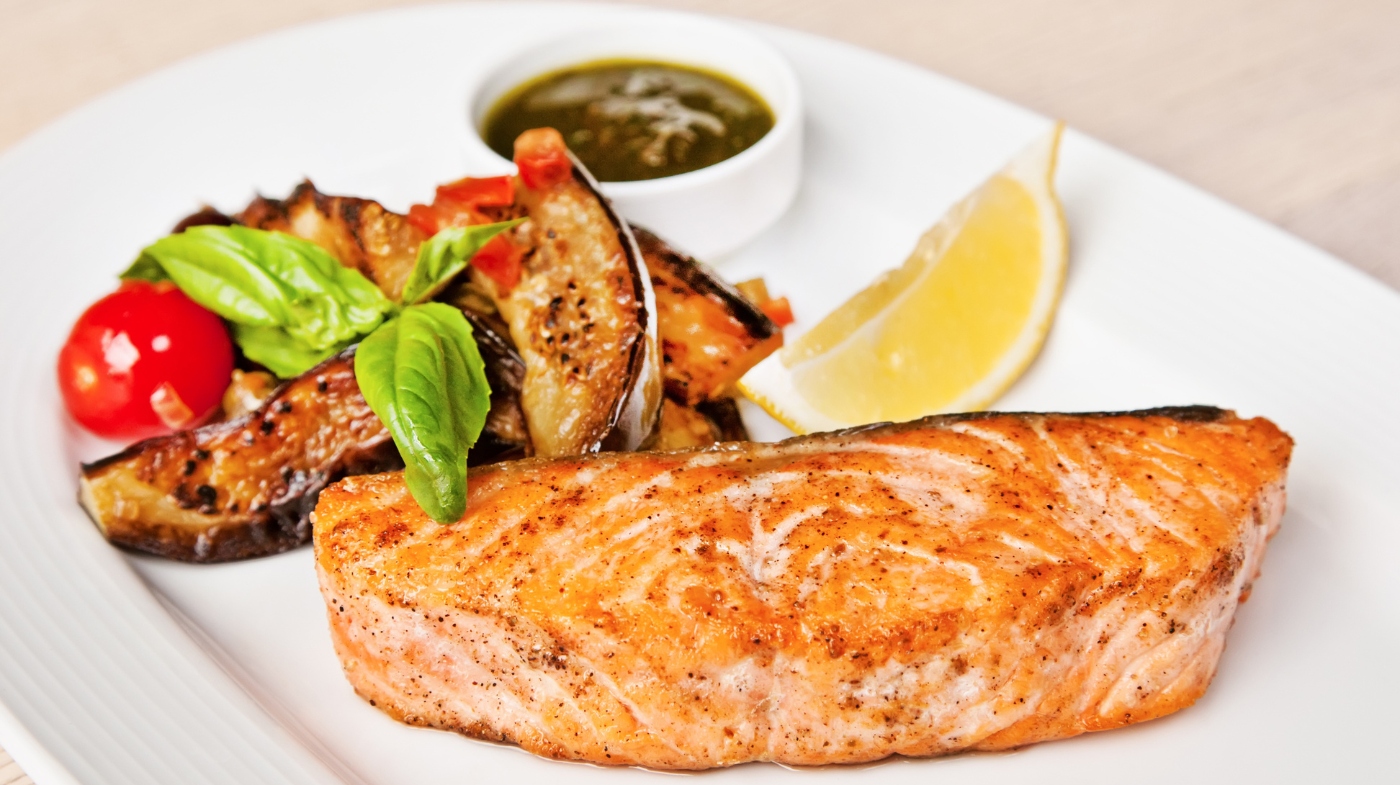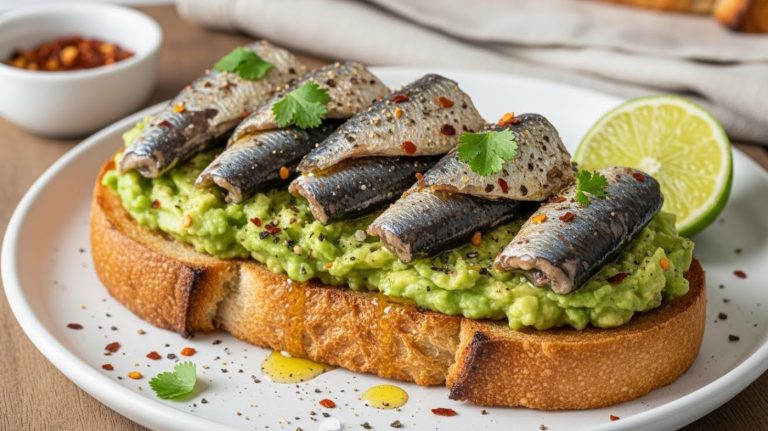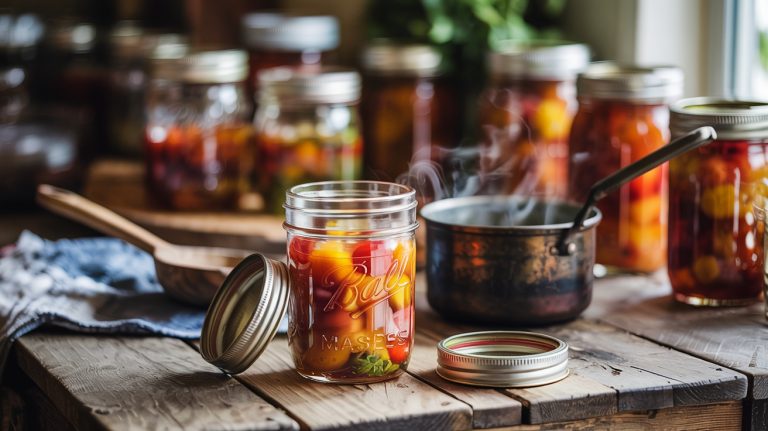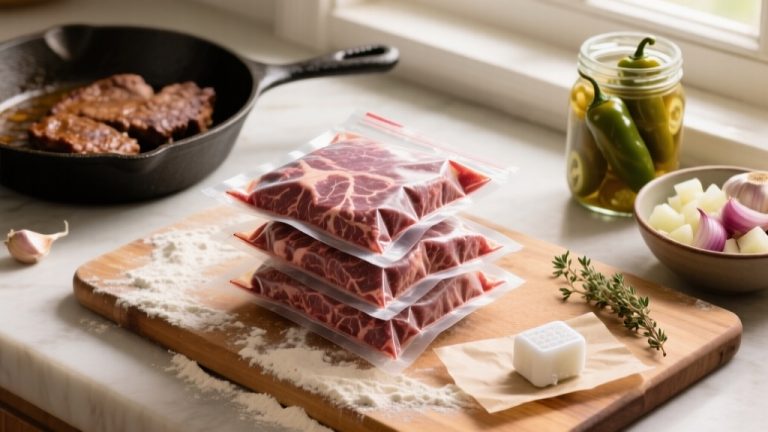Salmon Eggplant Recipe: A Balanced, Flavorful Dish
Choose firm, wild-caught salmon like Sockeye and fresh, glossy eggplant with a green calyx. Salt or soak eggplant to reduce bitterness before roasting at 425°F until caramelized.
Marinate salmon in olive oil, soy sauce, honey, and lemon juice for 30 to 60 minutes to boost flavor without compromising texture.
Bake salmon at 375°F for 12–15 minutes, then combine with eggplant for a balanced, savory meal. Explore further to discover seasoning tips and ideal side pairings.
Key Takeaways
- Choose firm, fatty salmon like King or Sockeye and fresh, blemish-free globe or Italian eggplant for optimal flavor and texture.
- Salt or soak eggplant slices for 30 minutes to reduce bitterness before roasting or grilling.
- Marinate salmon 30–60 minutes with olive oil, soy sauce, lemon juice, and honey for balanced umami, acidity, and sweetness.
- Roast eggplant at 425°F for 25-30 minutes, then add salmon baking at 375°F for 12-15 minutes to avoid overcooking.
- Serve with fresh herbs, lemon wedges, and grains like quinoa or couscous for a nutritious, flavorful meal.
Salmon Eggplant Recipe Table
| Ingredients | Process |
|---|---|
| 4 salmon fillets (6 oz each) | Marinate for 30-60 minutes in olive oil, soy sauce, lemon juice, and honey |
| 2 medium eggplants | Cut into 1-3 cm cubes, salt for 30 minutes, rinse and pat dry |
| Olive oil | Toss eggplant with oil, roast at 425°F for 25-30 minutes |
| Seasonings (salt, pepper, garlic) | Bake salmon at 375°F for 12-15 minutes until internal temp reaches 125°F |
| Fresh herbs & lemon | Rest both for 5 minutes, then serve with herbs and lemon wedges |
Selecting the Best Salmon and Eggplant for Your Dish
Selecting the best salmon and eggplant for your dish starts with understanding their distinct qualities and how they complement each other.
Choosing the right salmon and eggplant begins with knowing their unique qualities and how they enhance each other.
For salmon, choose firmer, fattier types like King (Chinook) or Sockeye to withstand robust cooking methods such as grilling or roasting. Their rich, buttery or bold flavors pair well with dense eggplants.
Chinook salmon, for example, is known for its rich, buttery flavor and firm, meaty texture, making it ideal for grilling. When preparing salmon, consider the optimal cooking temperature to preserve moisture and texture.
When selecting eggplant, opt for Globe or Italian varieties with firm, heavy flesh that holds shape during cooking. Look for smooth, shiny skin without blemishes and a fresh green calyx to guarantee freshness.
Salmon should have moist, translucent flesh with a mild scent, springing back when pressed. Prioritize wild-caught salmon for deeper color and firmer texture.
Preparing Eggplant to Enhance Flavor and Texture
To enhance your eggplant’s flavor and texture, start by soaking or salting it to reduce bitterness and control moisture. Eggplants are rich in dietary fiber, which aids in digestion and fullness.
Pay close attention to cutting styles—uniform, thicker slices improve cooking consistency and seasoning absorption. Finally, choose the right cooking method, whether roasting, grilling, or charring, to bring out the best taste and mouthfeel.
Soaking Techniques Benefits
Although eggplant offers a rich, creamy texture when cooked properly, soaking it beforehand greatly enhances both flavor and consistency.
By soaking sliced eggplant in a saltwater brine for about 30 minutes, you draw out bitter juices and excess moisture, firming the flesh and preventing sogginess. This step also reduces oil absorption during cooking, resulting in a less greasy, healthier dish.
After soaking, rinse the slices to remove excess salt and bitterness, balancing the flavor. Soaking accelerates cooking by allowing heat to penetrate more efficiently, ensuring tender yet intact pieces.
Additionally, soaking in flavored brines can infuse subtle savory notes, complementing salmon or tomato-based sauces. To maximize flavor, ensure that the brine solution cools to room temperature before adding the eggplant slices.
Cutting Styles Impact
When you prepare eggplant by cutting it into specific shapes, you directly influence its texture, flavor absorption, and cooking consistency.
Thin slices cook evenly and quickly, creating uniform layers perfect for dishes like eggplant parmesan. Cubes offer increased surface area, absorbing marinades well and caramelizing beautifully when roasted or stir-fried.
Wedges maintain a firm structure, balancing tender interiors with crisp edges, ideal for grilling. Halves retain moisture, providing creamy flesh suited for roasting or stuffing. Batons hold their shape during grilling and develop even browning.
Each cut also affects nutrient retention and oxidation; larger pieces like halves reduce exposed surface area, minimizing nutrient loss, while smaller cuts require prompt cooking to prevent browning.
Cooking Methods Comparison
How do different cooking methods transform eggplant’s flavor and texture? Roasting yields browned, toasty exteriors with tender, custardy interiors, enhancing complex toasted notes.
Braising delivers silky, creamy flesh that absorbs deep flavors, ideal for rich sauces. Grilling imparts smoky char while keeping the interior tender, perfect for layered dishes.
Smaller eggplants with glossy skin are often preferred for these methods as they tend to have better taste and texture.
| Method | Texture | Flavor Profile |
|---|---|---|
| Roasting | Tender, custardy | Toasty, caramelized |
| Braising | Silky, creamy | Deep, aromatic |
| Grilling | Soft interior, charred | Smoky, slightly bitter |
Selecting the right method depends on your dish’s texture and flavor goals, balancing moisture, caramelization, and flavor absorption to enhance the eggplant’s natural qualities.
Crafting the Perfect Marinade for Salmon
To craft the perfect marinade for salmon, focus on balancing key ingredients like olive oil, soy sauce, citrus, and sweeteners to enhance without overpowering.
You’ll want to tailor flavors carefully, combining savory, tangy, or herbaceous elements depending on your taste goals.
Keep marinating time between 30 to 60 minutes to guarantee ideal flavor absorption and texture preservation. Avoid exceeding 4-6 hours to prevent the salmon from becoming mushy, as extended marinating times can negatively affect the texture marinating time limits.
Key Marinade Ingredients
Although crafting the perfect marinade for salmon requires balance, understanding key ingredients makes the process straightforward.
You’ll start with liquid bases like olive oil to lock in moisture and soy sauce for umami and saltiness. Acidity from lemon juice tenderizes the fish while honey or brown sugar adds necessary sweetness.
Aromatics such as minced garlic and fresh herbs elevate the flavor profile without overpowering it. It is important to marinate the salmon for 30 minutes to 1 hour to allow the flavors to penetrate without curing the fish.
Key ingredients to focus on include:
- Olive oil for moisture retention
- Soy sauce for depth and salt balance
- Lemon juice to tenderize and brighten
- Honey or brown sugar for sweetness and caramelization
- Minced garlic and fresh herbs for aroma and complexity
Balancing Flavors Effectively
When crafting a salmon marinade, striking a precise balance among saltiness, sweetness, acidity, aromatics, and fat is essential to reveal the fish’s full flavor potential.
Start with salt—soy sauce or a pinch of salt brings forth salmon’s natural taste but needs sweetness like honey or brown sugar to avoid overpowering.
Add acidity from lemon juice or rice vinegar to brighten flavors and improve texture without “cooking” the fish. It is important to marinate salmon for no more than two hours when using acidic ingredients to prevent altering its texture. marinate for the right time
Incorporate aromatics such as fresh dill or minced garlic for complexity, ensuring they don’t mask salmon’s delicate profile.
Finally, include olive or sesame oil to enhance mouthfeel, aid flavor absorption, and promote caramelization.
Marinating Time Tips
Since marinating time directly affects both flavor absorption and texture, you’ll want to carefully control the duration salmon spends in the marinade. Ideally, marinate salmon for about 30 minutes at room temperature to maximize flavor without compromising texture.
This timing complements the quick bake process, as the salmon is baked for about 7 minutes with a gochujang glaze, ensuring a balanced cooking time.
Longer marinating (up to 8 hours) works well for miso-based marinades, enhancing umami. Avoid over-marinating, which softens the flesh due to acid breakdown. Keep salmon and eggplant separate to optimize texture and flavor.
- Marinate salmon 30 minutes at room temperature for balanced flavor.
- Refrigerate salmon if marinating over several hours to guarantee safety.
- Avoid acidic marinades longer than recommended to prevent mushiness.
- Thoroughly coat salmon and drizzle with sesame oil for moisture retention.
- Use a non-reactive container and cover to maintain marinade quality and prevent contamination.
Roasting Techniques for Tender Eggplant
To achieve tender, caramelized eggplant, you need to roast it at a high temperature while carefully managing the cut size and arrangement on the baking tray.
Cut the eggplant into 1- to 3-cm cubes to guarantee even cooking and prevent mushiness. Toss the pieces gently with about 1½ tablespoons of olive oil per medium eggplant, plus salt and pepper, using a rubber spatula to avoid breaking them.
Spread the cubes in a single layer on parchment-lined trays to avoid overcrowding and promote caramelization. Roasting eggplant with kosher or cooking salt enhances its flavor and texture. Roast at 425°F (218°C) for 25-30 minutes, flipping halfway with a sharp-edged spatula to preserve the caramelized skin.
Baking Salmon for Optimal Moisture and Flavor
Although baking salmon might seem straightforward, achieving the perfect balance of moisture and flavor requires careful attention to temperature, timing, and preparation.
Baking salmon well demands precise temperature, timing, and prep to balance moisture and flavor perfectly.
You want to bake at 375°F (190°C) for 12–15 minutes, targeting an internal temperature of about 125°F for tender, moist results.
Preparing the salmon by bringing it to room temperature and coating it with a butter or oil-based marinade seals in juices and enhances flavor. Using wild-caught salmon is recommended for better nutrition and flavor.
Resting the fish after baking lets the juices redistribute, avoiding dryness.
- Use moderate oven heat for even cooking and moisture retention
- Marinate at least 30 minutes with olive oil, lemon, garlic, and herbs
- Avoid overcooking; remove slightly before full doneness for carryover cooking
- Consider baking en papillote to lock in steam and flavor
- Finish with a brief broil for a golden crust without drying out the fish
Combining Salmon and Eggplant on a Sheet Pan
Mastering the art of combining salmon and eggplant on a single sheet pan requires careful attention to timing and arrangement. Start by roasting bite-sized eggplant pieces tossed in oil and seasoning alone for 10-15 minutes to soften and brown them.
Then, push the eggplant aside and add the salmon fillets skin-side down, maintaining space for even cooking. Return the sheet pan to the oven for 10-14 minutes until the salmon reaches 145°F and the eggplant is tender with caramelized edges.
Thoughtful positioning of ingredients on the sheet pan helps prevent burning and ensures even cooking throughout the process prevents burning.
| Step | Purpose |
|---|---|
| Roast eggplant first | Soften and brown edges |
| Add salmon later | Prevent overcooking salmon |
| Maintain spacing | Guarantee even heat circulation |
Flavor Enhancers and Seasoning Tips
When you enhance salmon and eggplant with carefully selected herbs, spices, and acids, you reveal layers of flavor that elevate the dish beyond simple roasting.
Use za’atar or sumac to impart tangy, earthy brightness, while cumin adds warmth and subtle nuttiness. Brighten the richness with fresh dill or parsley and a squeeze of lemon juice.
Za’atar or sumac add tangy brightness, cumin brings warmth, and fresh herbs with lemon brighten the richness.
Don’t forget kosher salt to season evenly and draw out moisture from the eggplant, concentrating its flavor. Salting eggplants before baking is a traditional method that can reduce bitterness and improve texture by drawing out excess moisture salting eggplants before baking.
Finish with extra virgin olive oil or a drizzle of tahini for richness and silky texture.
- Za’atar and sumac for tangy, herbal notes
- Cumin and Urfa chili flakes for warmth and mild heat
- Fresh herbs like dill and parsley for brightness
- Lemon juice to cut through richness
- Kosher salt to enhance natural flavors
Complementary Sides and Serving Suggestions
A variety of complementary sides can enhance your salmon and eggplant dish by adding texture, color, and flavor contrasts.
Pair grilled or roasted eggplant with crisp broccolini or asparagus for green freshness. A tomato-eggplant compote offers acidity and sweetness that complements salmon perfectly.
Include mixed greens or arugula salads to balance the dish’s richness. For grains, serve couscous, quinoa, or a nutty wild rice pilaf to absorb savory juices.
Crusty bread or garlic butter toast works well for scooping. Drizzle basil vinaigrette or a yogurt-garlic dressing over the plate to add brightness and cooling notes.
Finally, garnish with torn basil leaves, lemon zest, or microgreens to elevate visual appeal and aroma, creating a well-rounded, inviting presentation.
Nutritional Benefits of Salmon and Eggplant Meals
Bringing together salmon and eggplant not only creates a flavorful meal but also delivers a powerful combination of nutrients that support your overall health.
Salmon provides omega-3 fatty acids essential for heart and brain function, along with high-quality protein for muscle repair. Eggplant offers dietary fiber to aid digestion and antioxidants that protect your cells. Together, they enhance cardiovascular health, support bone strength, and boost immunity.
Salmon’s omega-3s and eggplant’s fiber combine to boost heart health, bone strength, and immunity.
- Omega-3s in salmon reduce inflammation and improve vascular function
- Fiber in eggplant lowers LDL cholesterol and promotes satiety
- Vitamin D and minerals from both support bone density
- Antioxidants combat oxidative stress, reducing chronic disease risk
- Protein and fiber aid in weight management and metabolic health
This nutrient-dense pairing guarantees you nourish your body while enjoying a delicious meal. For optimal flavor and nutrition, it is best to sear salmon filets before combining with eggplant and sauce.
Frequently Asked Questions
Can I Substitute Other Fish for Salmon in This Recipe?
You can definitely substitute other fish for salmon, but choose ones with firm texture and mild flavor like cod or halibut to hold up during cooking.
Adjust seasoning and cooking time since these fish cook differently and have less oiliness than salmon. Adding a glaze or marinade helps maintain moisture and flavor.
Avoid thin fillets that dry out quickly, and consider fish like trout if you want a richer taste but with careful seasoning adjustments.
How Do I Store Leftover Cooked Salmon and Eggplant?
Like preserving a moment in a bottle, you should store leftover cooked salmon and eggplant in airtight containers to lock in freshness.
Keep them refrigerated below 40°F and consume within 3–4 days.
Cool leftovers to room temperature before storing, avoid stacking for even cooling, and separate them from strong odors.
Freeze for up to 3 months using freezer-safe packaging. Always reheat leftovers to 165°F before enjoying for safety.
Can This Recipe Be Made in an Air Fryer?
You can definitely make salmon and eggplant dishes in an air fryer. Just preheat it to about 375-400°F, place seasoned eggplant rounds or halves at the bottom, and lay marinated salmon on top.
Cook for 7-20 minutes depending on thickness. Fatty salmon varieties like King or Atlantic work best to keep moisture. Monitor closely to avoid drying out, and consider resting salmon briefly after cooking for ideal texture and flavor.
Are There Vegan Alternatives to Salmon for This Recipe?
Yes, you can use vegan alternatives like firm tofu wrapped in seaweed to mimic salmon’s texture and flavor. Tempeh marinated in umami-rich sauces or jackfruit with savory seasonings works well too.
Mushrooms like king oyster offer a meaty texture, while rehydrated textured vegetable protein (TVP) replicates flaky fish.
Adding smoked paprika, liquid smoke, or seaweed enhances that oceanic taste, ensuring your dish stays flavorful and satisfying without fish.
Cook Fresh, Cook Right: Savor Tender Salmon and Roasted Eggplant
By selecting fresh salmon and firm eggplant, you set the stage for a dish that sings with flavor and texture. Remember, “the proof is in the pudding”—your careful roasting and baking will reveal tender, juicy results.
With the right marinade and seasoning, you’ll elevate this simple combination into a memorable meal. Serve it alongside vibrant sides to balance the plate, and enjoy the rich nutrients that make this recipe as healthy as it is delicious.







